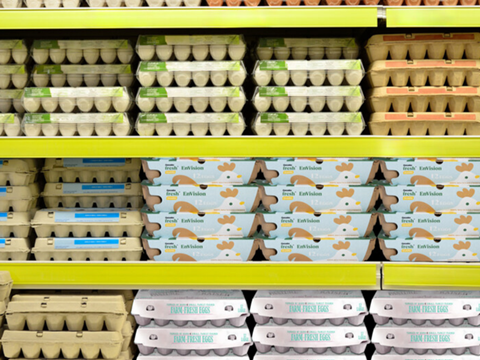
Cascades has announced the launch of its complete packaging solution for the egg market - Fresh GUARD EnVision - aiming to enhance egg visibility and protection and optimize packaging operations.
Apparently targeting the needs of processors, retailers and consumers, the solution has sleeve openings and a ‘highly resistant’ design. Cascades says the pack can be a comprehensive solution for egg processors, as it offers the equipment, packaging and technical knowledge to automate its customers’ end-of-line operations, hoping to improve efficiency.
Consisting of a moulded pulp base and a sleeve made from coated recycled board, the solution is said to be made from 100% recycled fibres and is pre-qualified as widely recyclable by How2Recycle.
The product has reportedly been tested for its durability for shelf stocking, transport and use. According to a study conducted by Cascades’ Research and Development centre, eggs are better protected compared to a 12-egg carton with a label, as tests show that Fresh GUARD EnVision triples the packaging’s rigidity and doubles its stacking strength.
“This innovation challenge aimed to develop a solution that was sustainable, attractive, efficient, and comprehensive. We are confident that this solution will enable us to accelerate our growth in the specialized egg industry,” said Jérôme Porlier, president and chief operating officer of Cascades Specialty Products Group.
Cascades Fresh GUARD EnVision is currently available in a 12-egg format.
At the start of the year, we spoke to Huhtamaki North America’s VP for Sustainability and Communications, Michael Hodges, and Sales Account Manager Tyler Hodges as part of our Packaging Europe podcast series. The discussion included fibre-based packaging - in particular fibre-based egg packaging - in the US market and highlighted challenges and opportunities around sustainability and legislation.
ICA Sweden recently implemented Stora Enso’s moulded wood fibre trays for flowers in place of traditional polystyrene alternatives, claiming that the transition reduces CO2 emissions by up to 81%. The trays are said to constitute sustainably sourced Nordic wood fibre and are reportedly produced using 100% green electricity.
If you liked this story, you might also enjoy:
How are the top brands progressing on packaging sustainability?
The ultimate guide to global plastic sustainability regulation











No comments yet